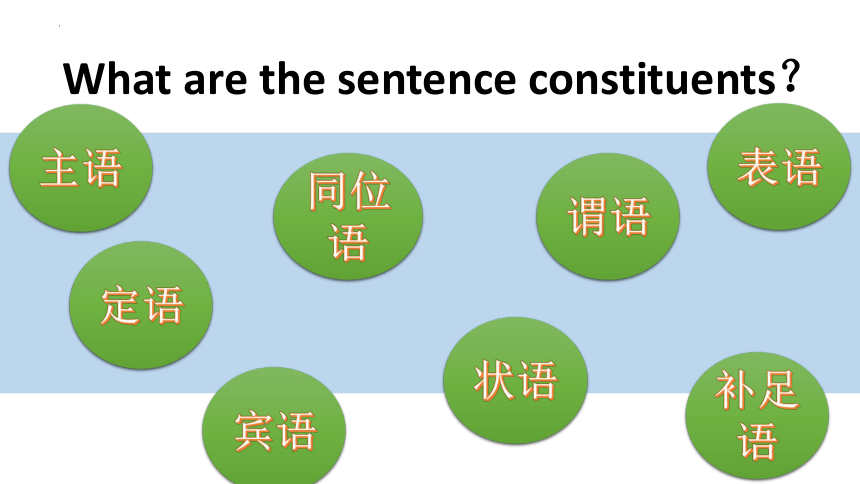2022-2023学年高考英语衔接句子成分分析课件(22张PPT)
文档属性
| 名称 | 2022-2023学年高考英语衔接句子成分分析课件(22张PPT) |  | |
| 格式 | pptx | ||
| 文件大小 | 2.1MB | ||
| 资源类型 | 教案 | ||
| 版本资源 | 通用版 | ||
| 科目 | 英语 | ||
| 更新时间 | 2023-03-01 20:09:03 | ||
图片预览









文档简介
(共22张PPT)
句子成分分析
Sentence constituents
Do you know what is sentence constituent?
句子的组成成分叫句子成分。在句子中,词与词之间有一定的组合关系,按照不同的关系,可以把句子分为不同的组成成分。句子成分又分主要成分和次要成分。
What are the sentence constituents?
主语
谓语
定语
表语
状语
补足语
宾语
同位语
主语 subject(S)
是句子要说明的人或事物,是句子的主体,说明动作是“谁,什么”发出的。一般由名词、代词、数词、不定式或动名词等充当。
Practice
The girl can sing many English songs. (名词)
We are students. / This is my pen . /Yours is on the desk.(代词)
One of my classmates is from Shanghai. / Two and three is five.(数词)
The old need more help.(名词化的形容词)
It is easy to learn English. (不定式)
Eating too much is bad for your health.(动名词)
谓语
verb(V)
说明主语的动作或状态,也是句子的主体部分,一般由动词充当。
动词分为实义动词、连系动词、情态动词和助动词。
1) 由单一动词作谓语
2) 情态动词加主要动词
3) 助动词加主要动词构成谓语
Practice
We study English.
He has an English- Chinese dictionary.
We can play the piano.
You must see the doctor.
She is talking with her sister.
I have seen this man before.
宾语
object(O)
是及物动词所涉及的对象,是动作的对象或承受者。一般由名词、代词、不定式及动名词等充当。
Practice
I like China. (名词)
Everybody likes her.(代词)
I want three.(数词)
Please pass me the first. (数词)
She wants to go home.(不定式)
We like playing football.(动名词)
宾语
object(O)
直接宾语与间接宾语。
有些及物动词可带有两个宾语,其中一个指物(直接宾语),另一个指人(间接宾语)。我们称为双宾语。
Practice
1) 动词+间接宾语(人)+直接宾语(物)
Mr. Wang teaches us English.
My mother gives me ten yuan.
2) 动词+直接宾语(物)+(to, for)+间接宾语(人)
My mother gives me ten yuan. = My mother gives ten yuan to me.。
表语
predicative(P)
用于说明主语的身份、特征或感受,一般由名词、数词、形容词、分词等充当。常用的连系动词有:be,look,get,sound(听起来),feel,become, smell,turn,taste(尝起来)等。
Practice
They are workers. (名词)
Two and three is five.(数词)
The story is very interesting.(形容词)
My job is teaching English.(动名词)
She is at home.(介词短语)
He is here.(副词)
定语
attributive(attrib)
用于修饰名词或代词,一般由形容词、名词、数词、不定式等充当。
【注意】定语一般位于被修饰词之前,但若修饰不定代词或不定式等短语作定语,则放在后面。
Practice
She is a beautiful girl. (形容词)
She is an English teacher.(名词)
There are two students in the classroom.(数词)
This song is better than that one. (代词)
Do you know the young man over there (副词)
We have something to do tomorrow.(不定式)
The man in blue is my brother.(介词短语)
状语
adverbial
用于修饰动词、形容词、副词或全句,一般由副词、介词短语、不定式短语或从句充当。单个副词作状语一般放在被修饰词之前,短语或从句放在句首或句末。分为地点,时间,原因,目的,结果,让步,条件,程度,方式和伴随状语。
Practice
Thank you very much.(副词表示程度)
The old man is walking slowly. (副词表示方式)
He usually gets up at six.(副词表示时间)
We all work here.(副词表示地点)
I get up at five in the morning.(介词短语表示时间)
补足语
complement (C)
用于补充说明宾语的动作,一般位于宾语之后,宾语与宾语补足语一起构成复合宾语。需接复合宾语的动词有:tell,let,help,teach, ask,see,have,order,make等。“宾补”一般由不定式短语、分词、名词、形容词等充当。
Practice
We elected him monitor. (名词)
I found it difficult to learn English well. (副词)
We find the story very interesting. (形容词)
I found her in the room.(介词)
同位语
appositive
对名词或代词进行补充说明或进一步的解释说明。
Practice
We young people should respect the old.
He himself will do the experiment.
He told me the news that our team won the game.
Thank You
句子成分分析
Sentence constituents
Do you know what is sentence constituent?
句子的组成成分叫句子成分。在句子中,词与词之间有一定的组合关系,按照不同的关系,可以把句子分为不同的组成成分。句子成分又分主要成分和次要成分。
What are the sentence constituents?
主语
谓语
定语
表语
状语
补足语
宾语
同位语
主语 subject(S)
是句子要说明的人或事物,是句子的主体,说明动作是“谁,什么”发出的。一般由名词、代词、数词、不定式或动名词等充当。
Practice
The girl can sing many English songs. (名词)
We are students. / This is my pen . /Yours is on the desk.(代词)
One of my classmates is from Shanghai. / Two and three is five.(数词)
The old need more help.(名词化的形容词)
It is easy to learn English. (不定式)
Eating too much is bad for your health.(动名词)
谓语
verb(V)
说明主语的动作或状态,也是句子的主体部分,一般由动词充当。
动词分为实义动词、连系动词、情态动词和助动词。
1) 由单一动词作谓语
2) 情态动词加主要动词
3) 助动词加主要动词构成谓语
Practice
We study English.
He has an English- Chinese dictionary.
We can play the piano.
You must see the doctor.
She is talking with her sister.
I have seen this man before.
宾语
object(O)
是及物动词所涉及的对象,是动作的对象或承受者。一般由名词、代词、不定式及动名词等充当。
Practice
I like China. (名词)
Everybody likes her.(代词)
I want three.(数词)
Please pass me the first. (数词)
She wants to go home.(不定式)
We like playing football.(动名词)
宾语
object(O)
直接宾语与间接宾语。
有些及物动词可带有两个宾语,其中一个指物(直接宾语),另一个指人(间接宾语)。我们称为双宾语。
Practice
1) 动词+间接宾语(人)+直接宾语(物)
Mr. Wang teaches us English.
My mother gives me ten yuan.
2) 动词+直接宾语(物)+(to, for)+间接宾语(人)
My mother gives me ten yuan. = My mother gives ten yuan to me.。
表语
predicative(P)
用于说明主语的身份、特征或感受,一般由名词、数词、形容词、分词等充当。常用的连系动词有:be,look,get,sound(听起来),feel,become, smell,turn,taste(尝起来)等。
Practice
They are workers. (名词)
Two and three is five.(数词)
The story is very interesting.(形容词)
My job is teaching English.(动名词)
She is at home.(介词短语)
He is here.(副词)
定语
attributive(attrib)
用于修饰名词或代词,一般由形容词、名词、数词、不定式等充当。
【注意】定语一般位于被修饰词之前,但若修饰不定代词或不定式等短语作定语,则放在后面。
Practice
She is a beautiful girl. (形容词)
She is an English teacher.(名词)
There are two students in the classroom.(数词)
This song is better than that one. (代词)
Do you know the young man over there (副词)
We have something to do tomorrow.(不定式)
The man in blue is my brother.(介词短语)
状语
adverbial
用于修饰动词、形容词、副词或全句,一般由副词、介词短语、不定式短语或从句充当。单个副词作状语一般放在被修饰词之前,短语或从句放在句首或句末。分为地点,时间,原因,目的,结果,让步,条件,程度,方式和伴随状语。
Practice
Thank you very much.(副词表示程度)
The old man is walking slowly. (副词表示方式)
He usually gets up at six.(副词表示时间)
We all work here.(副词表示地点)
I get up at five in the morning.(介词短语表示时间)
补足语
complement (C)
用于补充说明宾语的动作,一般位于宾语之后,宾语与宾语补足语一起构成复合宾语。需接复合宾语的动词有:tell,let,help,teach, ask,see,have,order,make等。“宾补”一般由不定式短语、分词、名词、形容词等充当。
Practice
We elected him monitor. (名词)
I found it difficult to learn English well. (副词)
We find the story very interesting. (形容词)
I found her in the room.(介词)
同位语
appositive
对名词或代词进行补充说明或进一步的解释说明。
Practice
We young people should respect the old.
He himself will do the experiment.
He told me the news that our team won the game.
Thank You
